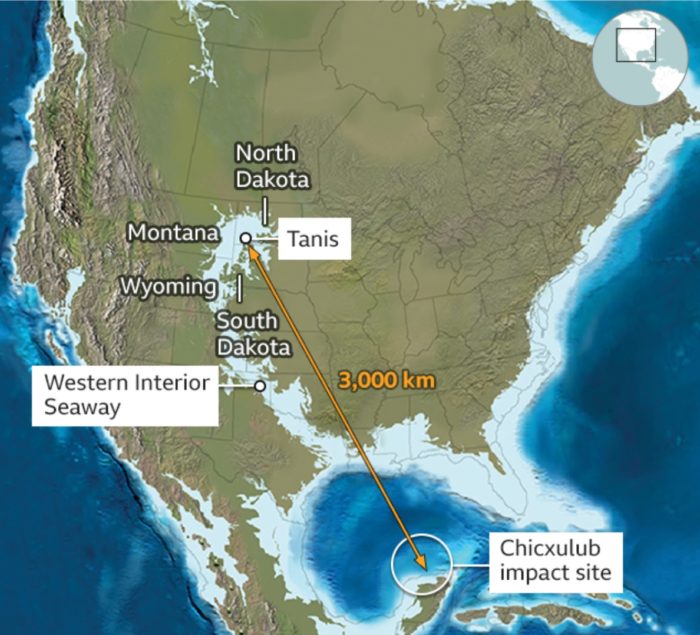Apr 11 2022
The Day the Dinosaurs Died
 This is one of the coolest science news stories of the last decade, and I’m a bit surprised it’s not getting more play. Paleontologists have discovered and been examining a fossil deposit from the exact day that the asteroid hit 66 million years ago, at the K-Pg boundary. The site is in Tanis (isn’t that where the Ark of the Covenant was found?) North Dakota (Oh, so no). Actually it’s the Tanis site within the Hell’s Creek formation, which is a productive fossil bed. How can scientists be sure what they are looking at comes from the time of impact? That’s one of the interesting parts of the story.
This is one of the coolest science news stories of the last decade, and I’m a bit surprised it’s not getting more play. Paleontologists have discovered and been examining a fossil deposit from the exact day that the asteroid hit 66 million years ago, at the K-Pg boundary. The site is in Tanis (isn’t that where the Ark of the Covenant was found?) North Dakota (Oh, so no). Actually it’s the Tanis site within the Hell’s Creek formation, which is a productive fossil bed. How can scientists be sure what they are looking at comes from the time of impact? That’s one of the interesting parts of the story.
What appears to have happened is that a large asteroid, about 12 km wide, struck the Yucatan peninsula in the Gulf of Mexico. The crater (Chicxulub crater) from the impact can still be seen. The impact threw a lot of material up into the atmosphere. It also caused a massive tidal wave that spread out, sending material along the Gulf shore, across Mexico, and up along the coasts. But part of this wave also snaked north along a riverbed that led inland to where modern day Tanis is, 3,000 km away. There the water came to rest in a large basin. The wave had swept up sea and land creatures, depositing them in a jumble in the basin. That is one of the lines of evidence that this fossil deposit is a direct result of the impact, the mix of land and sea creatures so far inland, and the fact that the deposit appears to be the result of a sudden chaotic event. It would take something massive to do that, like a meteor impact in the gulf.
An interesting technical detail is that the wave was likely only partly a tidal wave phenomenon from the “splash” of impact. Published evidence indicates that the deposit also likely coincided with a seismic wave – a harmonic wave in the body of water resulting from the impact. So it was more like a megatsunami.
But it gets better. The sturgeon and paddlefish in the deposit have tiny spherules embedded in their gills. This could mean that they were breathing in the spherules when they were still alive. Spherules like these are created when molten material is thrown up into the air, then solidifies into tiny droplets as it rains back down again. They are a hallmark of meteor impacts. So these fish were still alive when debris from the impact was still raining down back to Earth.
Further still:
“When we noticed there were inclusions within these little glass spherules, we chemically analysed them at the Diamond X-ray synchrotron near Oxford,” explains Prof Phil Manning, who is Mr. DePalma’s PhD supervisor at Manchester.
When they chemically analysed the small inclusions within the glass spherules they found that they chemically matched the rock at Chicxulub. Also, some of the inclusions has an isotope signature that is consistent with an extraterrestrial origin. This likely means that they are pieces of the very meteor that struck the Earth that day.
Finally, the entire deposit is capped by “iridium-rich impactite”. The meteor that struck was rich in iridium of an extraterrestrial isotope, which was the first hint that the K-Pg boundary layer may have been caused by a impact.
All of this means that we have a fossil window into the day the meteor struck, causing the mass extinction event 66 million years ago. And – it’s a well preserved fossil window. There are a few reasons for this. First, the deposit was a sudden event, so many plants and animals were instantly buried in sediment. That sudden complete burial means that they would be preserved in good shape. There was no time for predation or for natural forces to degrade the animal tissue while it fossilized. It also means there are a lot of creatures present – plants animals and fish all mixed together.
As an example of the quality of the preservation, one of the fossils recovered is an isolated dinosaur leg. The leg was likely ripped from the animal during the powerful event. The fossil is not just bones, but includes soft tissue and skin. This is the best preserved dinosaur leg ever discovered.
This is clearly one of the most amazing fossil beds on Earth – tightly packed with fossils from within minutes to hours after the impact that killed the dinosaurs. Fortunately, it is about to get a lot of media attention. The BBC spent three years filming scientists examining the site, and will be airing their documentary on April 15th. The show is Dinosaurs: The Final Day with David Attenborough. Three papers have been published so far from this find, but it takes a long time to do a thorough scientific analysis and write it up in a paper. So there is a lot more discovered at Tanis than has been reported so far. This means we are likely to learn a lot about the fossil finds from the documentary. Should be incredible.






